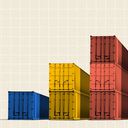Everything Shortage to last past Christmas

America's supply chain crisis, which has driven prices higher and made all sorts of goods harder to find, may last long after the holiday season.
The big picture: If goods aren't off a boat by now, it's highly unlikely that they'll make it onto store shelves before Christmas. And there are dozens and dozens of ships anchored offshore at the country's biggest ports.
Around 40% of U.S. container imports come through the Ports of Long Beach and Los Angeles, but they aren't operating at full capacity.
Details: During an "Axios on HBO" visit last Tuesday morning, at least half of the visible terminal cranes were standing upright, which means they weren't removing containers from ships. The problems are legion and interconnected.
- U.S. consumers are buying more goods than ever before, thus increasing the number of arriving containers.
- There aren't enough trucks to remove all of the containers from the yards, which means cranes are forced to stop removing containers from ships.
- And all of this is exacerbated by a labor shortage, including both truckers and terminal mechanics, overstuffed warehouses, and an antiquated system that requires trucks to pick up a specific container within a specific time window (despite L.A. freeway traffic).
What happens next: Some consumer demand may wane after the holidays, helping the ports begin to catch up, but there are three more major trouble spots on the horizon:
1. The labor contract representing around 15,000 West Coast port workers expires next summer.
- This could be a very difficult negotiation, given the reinvigorated U.S. labor movement and the fact that freight shippers are generating massive profits — charging top dollar to desperate importers.
- Prior negotiations, in 2014, resulted in port shutdowns. It was bad then, but would be worse this time given the existing backups.
2. The International Maritime Organization, which oversees global ocean freight, has been implementing new rules whereby ships must reduce their carbon footprints (which contribute around 2.5% of global emissions).
- Some new technologies and fuels have been developed, but ships most commonly meet these goals by slowing down.
3. There could be a reverse logjam next year in Asia.
- Normally, a cargo ship would unload in Long Beach and then get filled back up with empty containers before returning to Asia.
- Today, however, the same problems plaguing ship unloading also applies to re-loading. Too little yard space, too few trucks, chasses, etc. The result is that some ships are leaving without enough empties, which could eventually impact the amount of cargo that's able to leave Asia for U.S. ports.
The bottom line: Time alone won't solve the supply chain crisis.